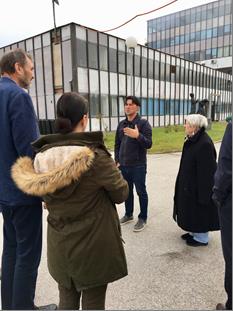Day 3: Srebrenica
A small section of the cemetery at Srebrenica. Photo credit: Ivan Deben Wells
While the Siege of Sarajevo was eventually brought to an end, events in other areas of Bosnia took a turn that will be forever etched into international memory and remain the subject of disagreement and dispute. I am of course very aware that my visit provided only a limited perspective and testimony of very complicated and complex issues associated with the tragic events that took place here.
We visited a museum housed at a former UN base and memorial cemetery which outlined the events that took place in Srebrenica. What follows here is a summary of the information and evidence presented both at the museum and in a subsequent meeting with two survivors of events in Srebrenica.
Srebrenica is a small town around two hours away from Sarajevo, and close to the border with Serbia. Serbian forces took control of the surrounding area as part of the newly formed Republika Srpska, formed for those Serbs living in Bosnia. The United Nations declared the enclave of Srebrenica a safe place for Muslims who, evidence suggests, were being cleansed and moved out of surrounding areas.
Srebrenica was of strategic importance to Repulblika Srpska. As a result of UN declarations, thousands of displaced Bosnian Muslims flocked there. While Srebrenica had been captured by Bosnian forces in 1992, Serb forces in the area, led by Ratko Mladic, had slowly reduced the size of the safe enclave until the area found itself under siege. The UN sent troops to keep the peace in the area but Serb forces refused to demilitarise, as for them this territory was too important. By 1995, very little food was getting into the area and people were dying of starvation.
In July of 1995, after failed meetings between the Dutch leader of UN troops and Mladic, leader of Serb forces, Dutch UN troops withdrew from Srebrenica, leaving the way clear for Serbian troops to take the town. Assurances were made by General Ratko Mladic that no harm would come to the thousands who had flocked to the sanctuary of the UN base at Potocari.

The former UN base at Potocari, now a museum. Photo credit: Ivan Deben Wells
While disputed by Serbia, evidence presented at the museum and accepted by the ICTY suggests that from 12 July, Serb soldiers began rounding up Muslim men and boys and separating them from the women. They were taken to sites around the area and executed.
Nejad and Hasan's stories
On our trip we met Nejad Avdic and Hasan Hasanovic. Both had harrowing stories to tell. Nejad told us his story of being part of one such execution. In 1992 Nejad’s family fled their home. After months of living in the woods, he and his family sought refuge in Srebrenica and lived in disused school buildings. Then Dutch forces arrived. Nejad explained that at first they were seen as rescuers but then they deserted them.
Nejad and other male members of his family were afraid to go to Potocari, where the UN base was, and so joined a column of men in the woods heading for Tuzla, the first town they knew they’d be safe. Lost in the woods, eventually Nejad and his family were captured. Nejad remembered truck loads of men and boys being transported to execution sites. He remembered lines of men 5 deep being shot at in the back from behind. Nejad told us he was shot in the leg and stomach. He only survived because as the truck drove away, he spotted another man moving. He called to him and the pair helped one another to release the ties that bound their arms and legs. The other man had a medical background and the two then survived in the woods together, making the arduous journey to Tuzla, the first safe area for Bosnian Muslims.
Hasan Hasanovic (pictured above) was a teenage boy at the time and remembers escaping into the woods as part of a column of men and boys. He told us that the column was shot at continually as they escaped into the woods. In the panic, Hasan lost his father and uncle.
“As much as I wanted to stop and look for them, I knew if I did, I would be killed. I told myself if I wanted to live, I would have to run and not look back.”
Hasan remembers hiding behind a tree in fear of his life for hours until the shots subsided. Serb forces blockaded the roads all around and used already captured men with loud hailers to call the names of their sons, brothers, uncles and fathers, telling them to come out. We were shown news footage of men calling to their loved ones at the museum.
Hasan told us that he did not respond to the calls as others did. He reached Tuzla eventually, after walking for 6 days, but had no skin left on his feet. Hasan now works at the former UN base at Potocari where the devastating events unfolded. The site is now a museum dedicated to the events that happened there and remembrance of the 8372 mainly Muslim men and boys who lost their lives.
A little further on from the base lies the cemetery where the dead are remembered and buried. Graves stretch for as far as the eye can see and really give a sense of scale and the awful consequences of war and conflict. We spent sombre moments at the cemetery before we left Srebrenica for Tuzla where we visited the repatriation facility there.
The ICTY at The Hague ruled that the events in Srebrenica amounted to genocide; however, this is fiercely disputed by Serbia.

